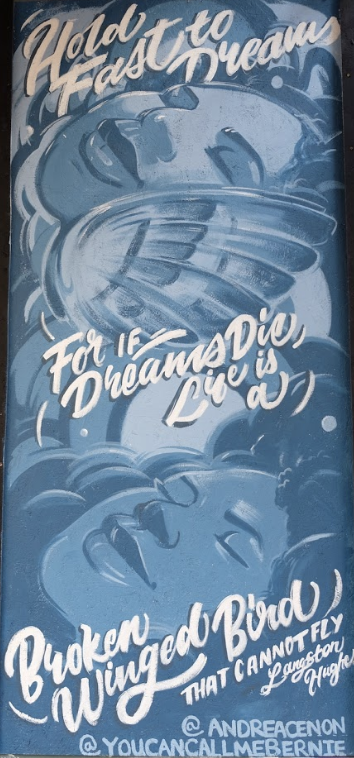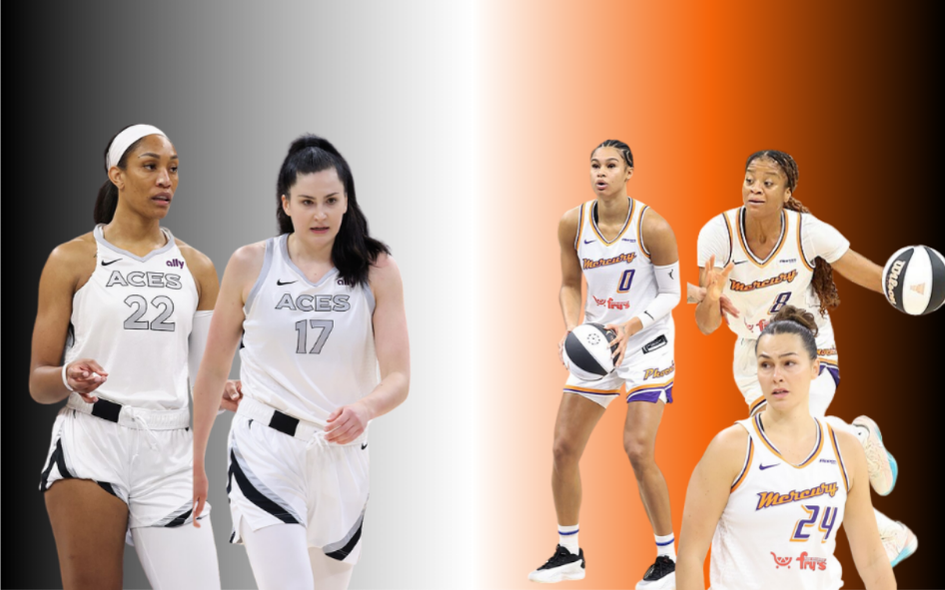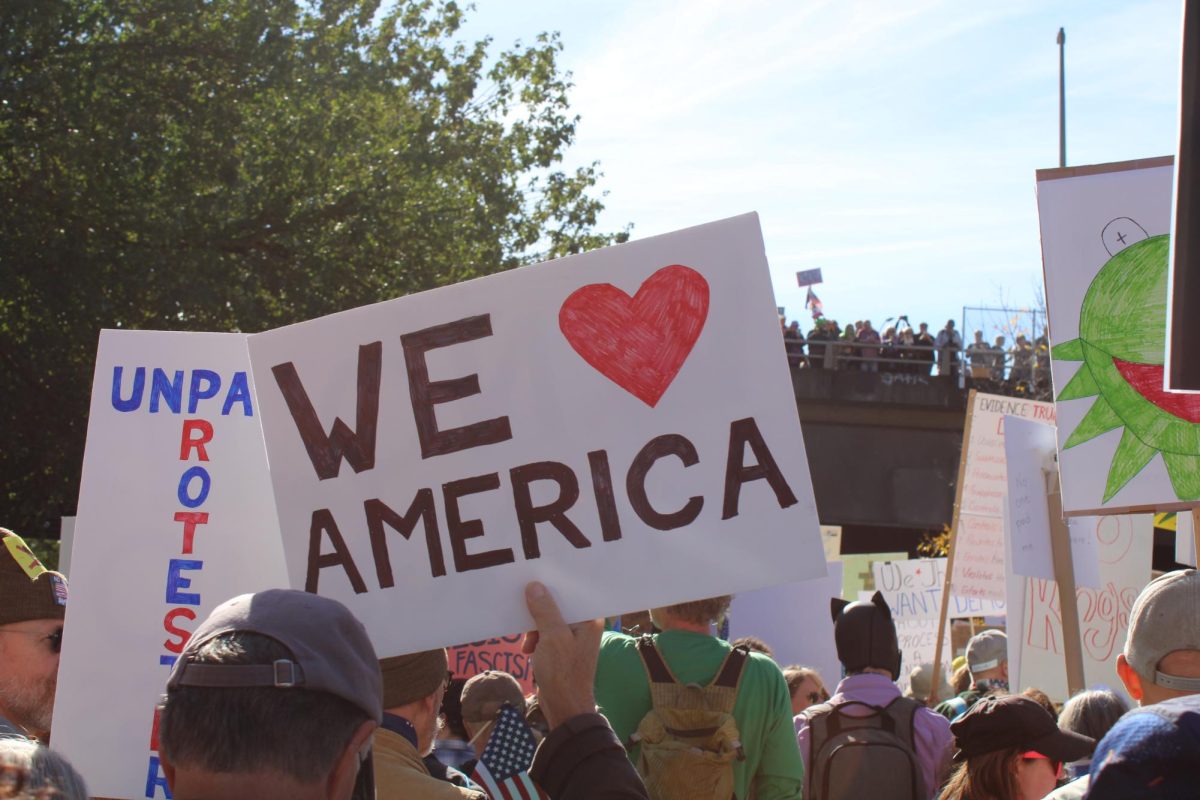Portland protest art: a reflection of the past, present, and future
This mural portraying a quote by Langston Hughes was painted by Bernadette Little and Andrea Cenon. You can find it located in Downtown Portland near Pioneer Square.
April 8, 2021
Walking through downtown Portland, you might stumble upon a blue mural depicting the face of a dreaming woman and an excerpt of the Langston Hughes poem “Dream” written in cursive. The mural exists among the many Black Lives Matter protest art pieces that illustrate the city. Meet Bernadette Little, the creative behind the mural.
Little, who is from Baltimore, MD, moved to Portland in 2017 to work as a graphic designer and art director. Her passion for art began in her early childhood and continues to be an integral part of her, allowing a channel for self-expression.
“I have always been into the arts. I actually started out, when I was really young, as a violinist and then that slowly merged more into the visual arts… Drawing and painting are my absolute favorites,” Little explains. “It has always been my first love and my way of expressing myself. I have never been a big extrovert… I’m definitely not a wordsmith or a poet. My way of expressing myself has always been through the visual arts.”
Little credits her love of art, specifically painting and drawing, to accessibility.
“You don’t need a lot of money, you don’t need a lot of tools, just whatever you can make to make a mark,” she says.
And for Little, her inspiration for art is everywhere.
“Everything is a story. The way that you move, the way that you act, the way that people react to you. Everything has something behind it. I think delving into those stories in everyday life is what inspires me.”
These days, Little has been concentrating on the intersection of her diverse passions and her educational background as a student. This focus has led her to emphasize the importance of protest art, a form of expression that transcends the racial, social, and economic barriers posed against artists and creatives today.
“I’m also a master’s student and… there have been some courses where we studied social change organizations so that on top of being involved in these mural projects has really cemented in my brain the transformative power of protest art. [Protest art is important] once again for that accessibility piece and its universal ability to provide a foundation for somebody to communicate, for somebody to get their ideas across that transverses language that transverses academia and overly complicated ways of communication. Even within the art world, the gallery space is a very colonized and institutionalized space. I think protest art gives people the ability to take down all those barriers and express themselves in a transformative way,” she said.
This summer, Little took to the walls of Portland to combine her talents with the push for social justice marked by the Black Lives Matter protests that flooded the streets. She began work on one of her protest art mural projects after fellow muralist and creative Solamée Souag (@c.hroma on Instagram) contacted her.
Little’s inspiration behind the mural is one that echoes the deep history of the United States, paying homage to the past civil rights leaders that have fought for change.
“The times that we live in are nothing new. They are new to us, but not to the history of society. I was thinking… the pull quote from Langston Hughes was indicative of that,” she said/says. “It speaks to the fact that this is a historical moment for us, but it is building upon the work of so many other people who have come before us. It is speaking to what is happening in our time and what happened in their time.”
But more than just a reflection of the past, Little’s mural is also indicative of the future.
“I also wanted [the mural] to be something slightly optimistic. I wanted it to be something [that reflects] we are fighting for a purpose, we are fighting for a cause, we are fighting for those dreams that we all still have and can achieve if we all work together,” she says.
In an effort to achieve this narrative, Little carefully planned her mural, painting in blue hues for a dreamy effect and using her sister as a reference for the sleeping female figure in the mural.
“I wanted it to be this contemplative piece that spoke to the past and the potential of the future. It was super fun to get my sister involved. The pull quote itself, I reached out to a friend named Andrea [Cenon] (@andreacenon on Instagram) who works with me and is a wonderful hand lettering artist. I knew that wasn’t my forte. We collabed on it… and I went down to the space with my partner and we got it up within a few days.”
Beyond just the planning and the execution of the mural, though, Little notes the important role that artists, especially those that are not thought of as being the stereotypical artist by mass media, have for the community.
“The actual process of being in a space and seeing artists that aren’t necessarily commonly portrayed in the media creating a large scale work is just as impactful as the work itself. For another young, fem out there seeing a fem artist or BIPOC artist paint this piece or a queer artist paint this piece is just as important as the final piece itself,” she said.
In addition to the blue mural , Little has worked on two other murals in downtown Portland. In Chinatown, she worked with Portland artists Christine Miller (@sincerelychristinemiller on Instagram) and Kali Grey (@kaligrey on Instagram), to create a mural portrait on Black Boy Joy, a recent movement that strives to redefine the way Black men and Black masculinity are viewed by society.
“It was a piece not only celebrating Black joy, but celebrating my friendship with the [mural] subject,” Little describes.
The most recent mural Little worked on this summer was in collaboration with Molly Mendoza (@msmollym on Instagram) and Elizabeth Haidle (@ehaidle on Instagram) to paint a mural for “ASK: Airway Science for Kids,” a science, technology, engineering, arts and mathematics program for underprivileged youth.
Now, entering 2021, Little is continuing her work on mural projects and impacting the community with her art. For other young artists, creatives, or inspiring change makers, Little has some advice.
“First and foremost: your voice matters. Don’t make yourself small. Even if you feel like you don’t have a certain technical ability… just go for it and try it anyway. Anything that you have to say that comes from your authentic self is worth you putting in the effort to put it out there. Not only is that going to be cathartic to you, but that is going to speak to somebody else and you won’t even know who that means that much for. Also, talk to other artists in your community… connect with people, share your stories. That is for me where my inspiration comes from and where I learn the most… So just share. Share everything. Even if you don’t think it’s ready, just share it and see what happens. You never know what might happen if you start a conversation.”
To check out more of Bernadette Little’s work, check out her Instagram @youcancallmebernie and her website www.youcancallmebernie.com.




